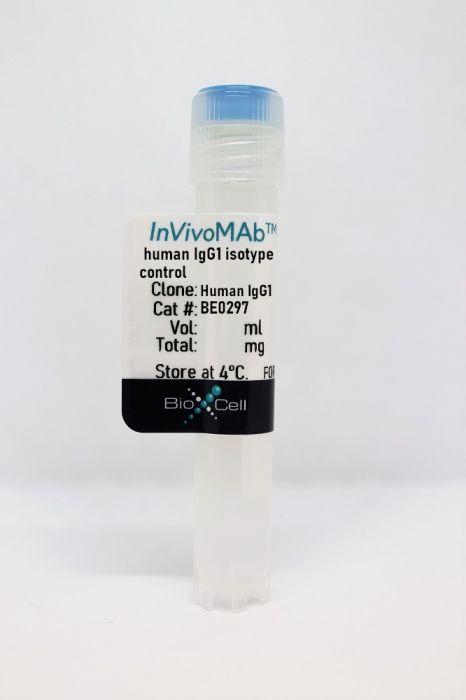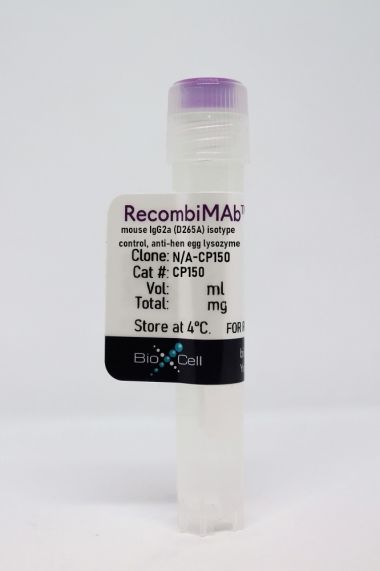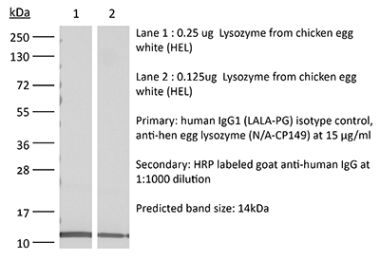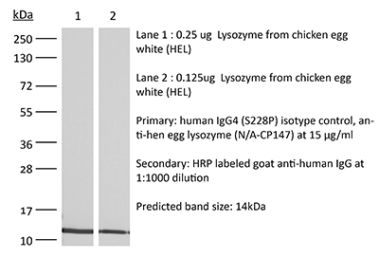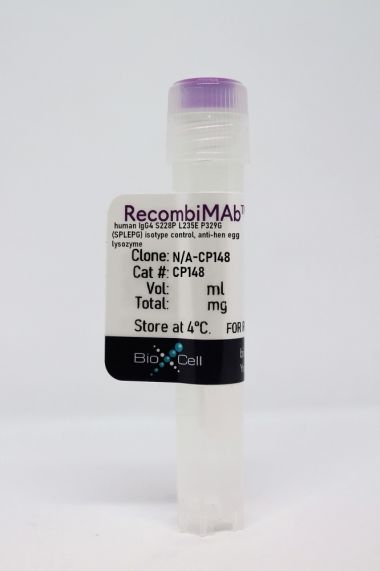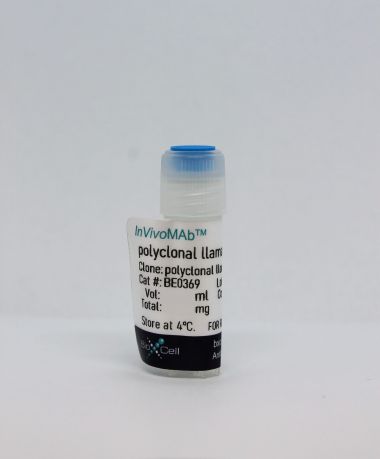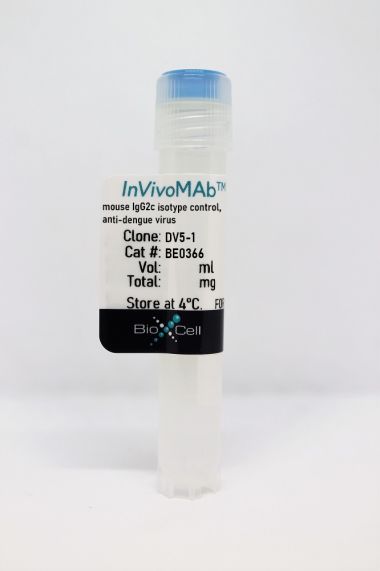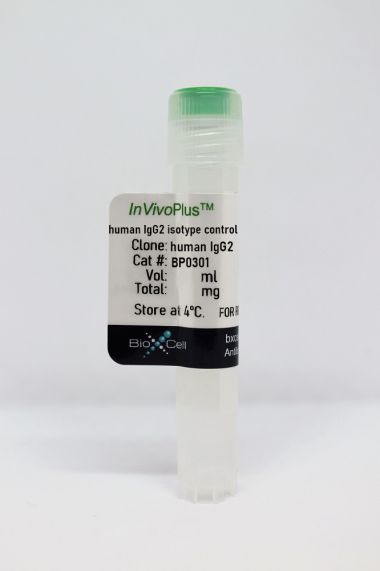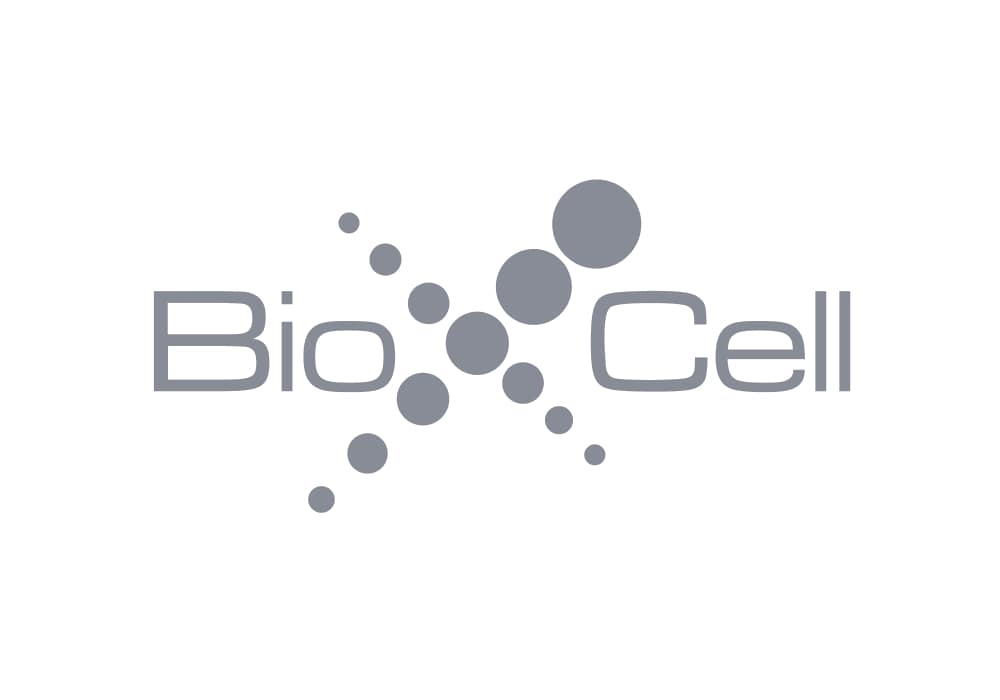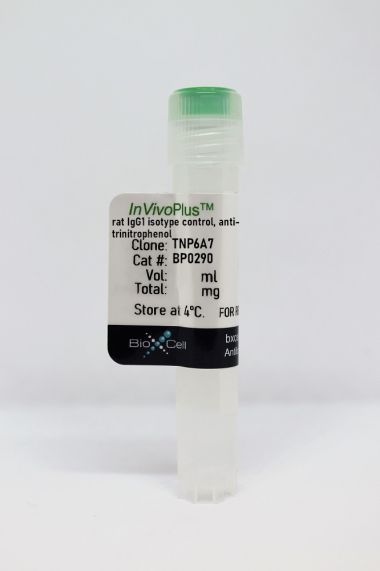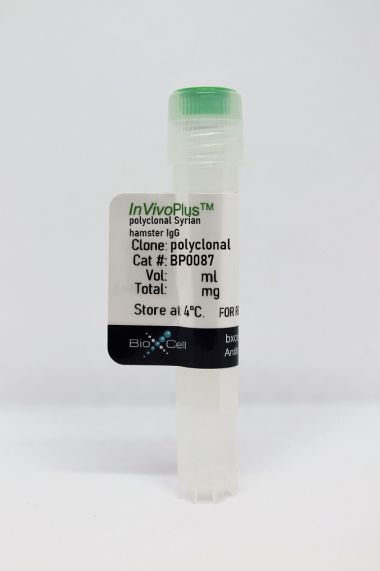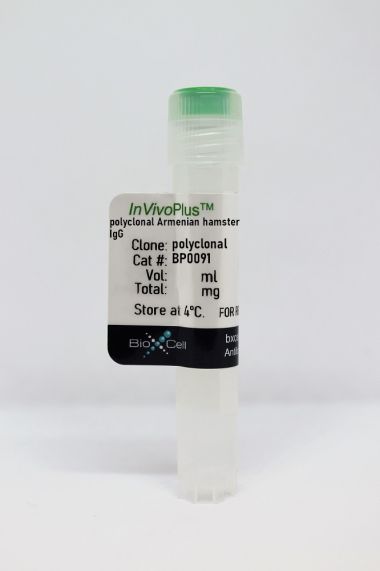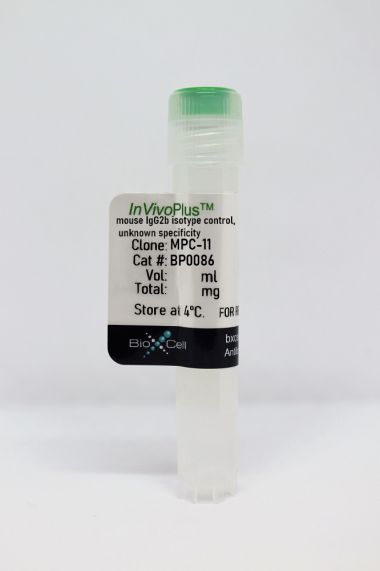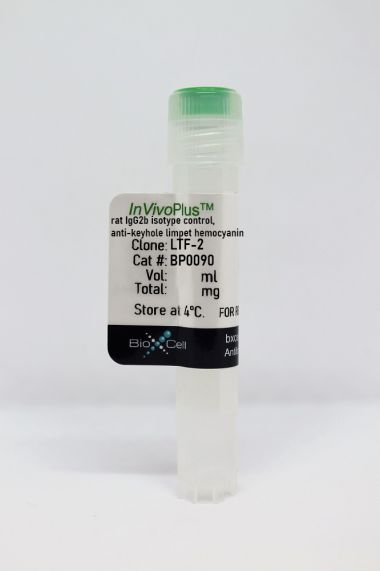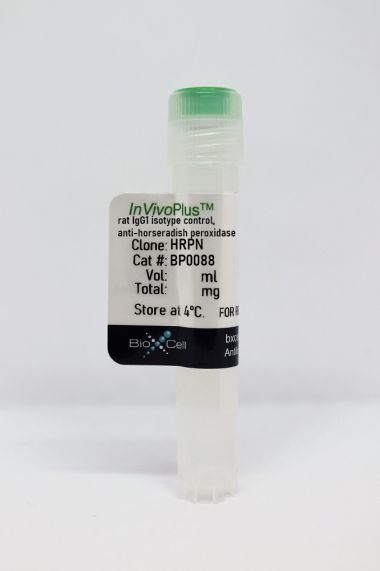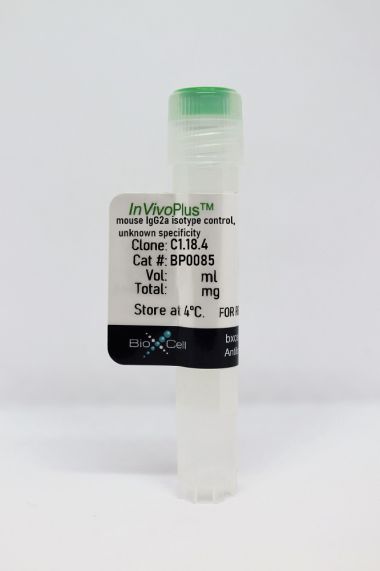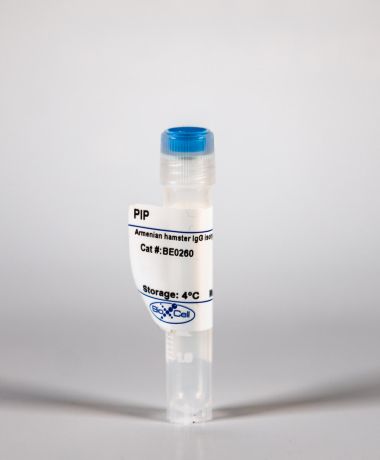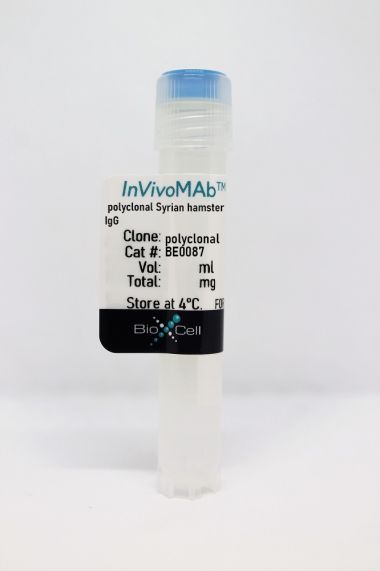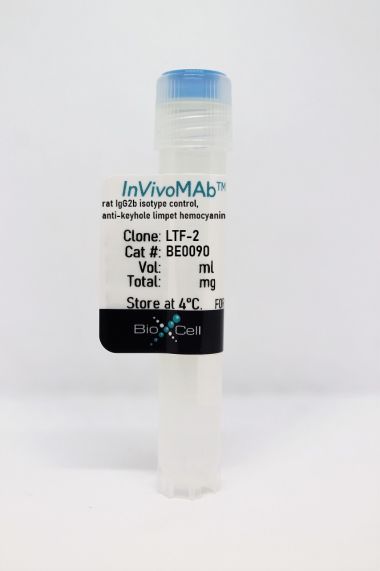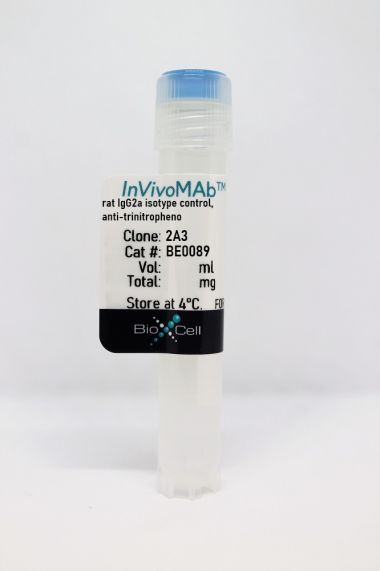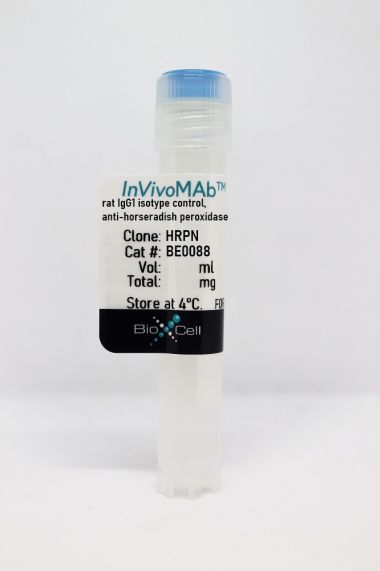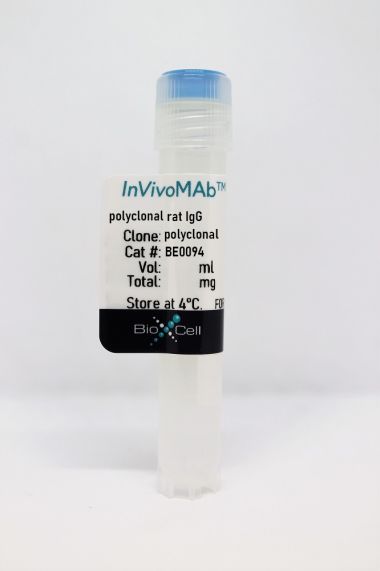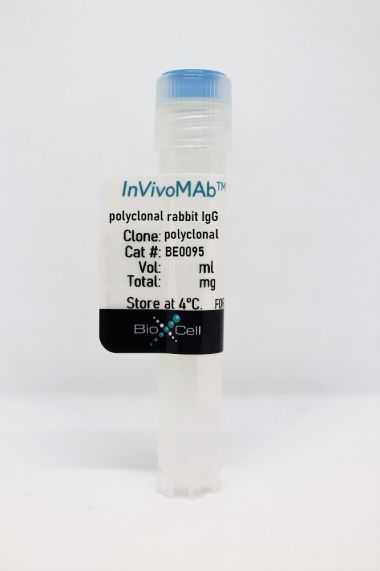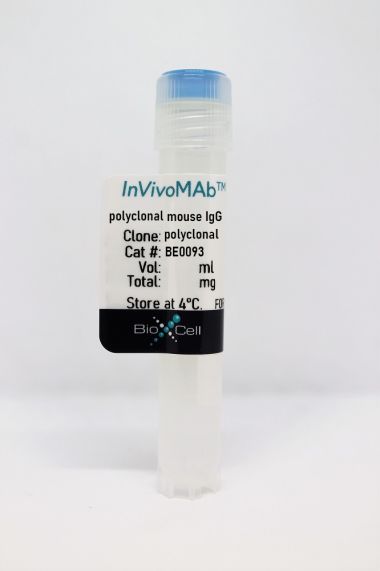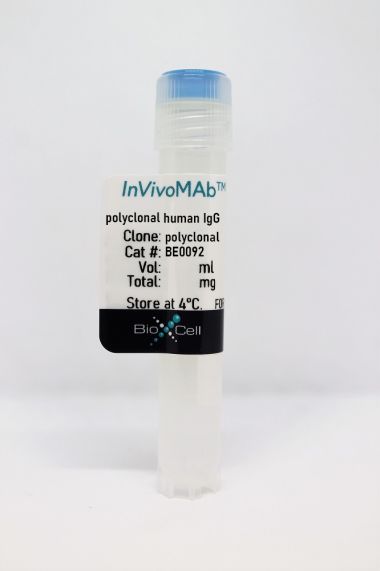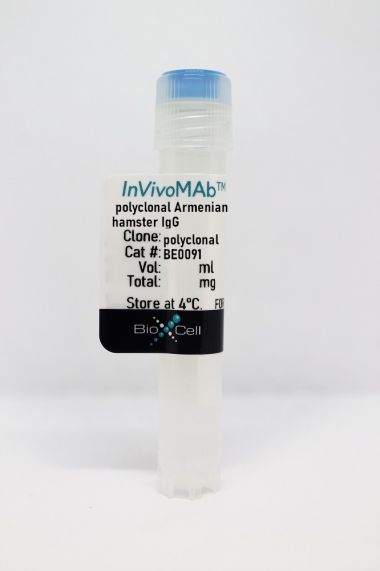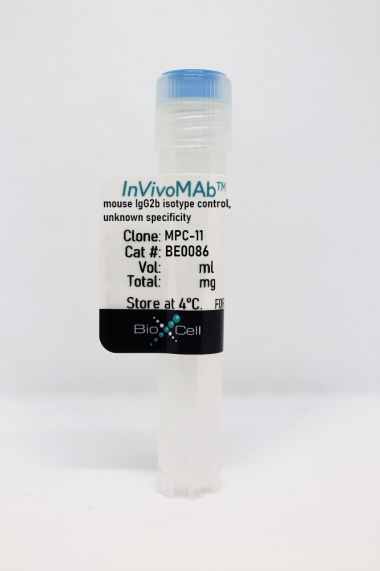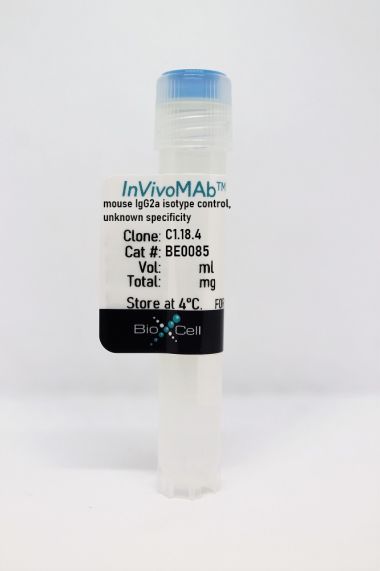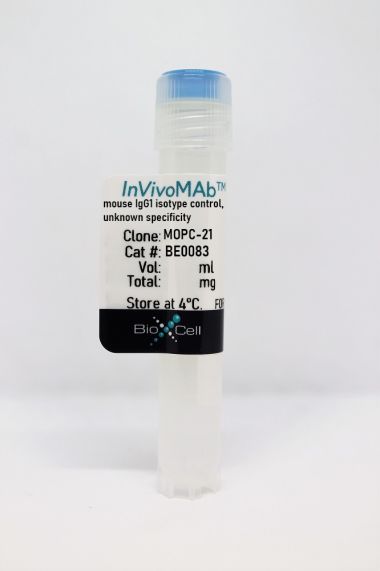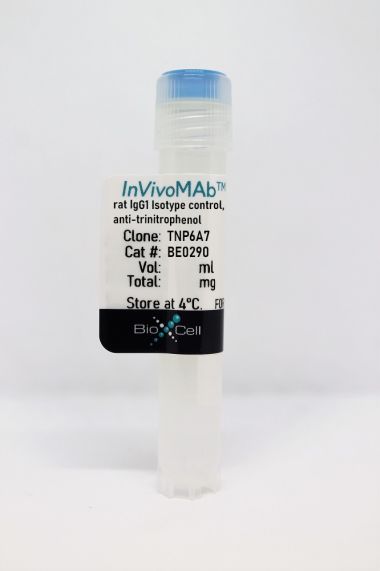InVivoMAb human IgG1 isotype control
Product Details
The human IgG1 isotype control antibody is purified from human myeloma serum and is of unknown specificity. This antibody is suitable for use as a non-targeting isotype control in various in vitro and in vivo studies. It can also be used as a negative control in various diagnostic applications such as ELISA, Western blot, immunofluorescence, immunohistochemistry, immunoprecipitation, and flow cytometry. For research use only.Specifications
| Isotype | Human IgG1, κ |
|---|---|
| Recommended Dilution Buffer | InVivoPure pH 7.0 Dilution Buffer |
| Conjugation | This product is unconjugated. Conjugation is available via our Antibody Conjugation Services. |
| Formulation |
PBS, pH 7.0 Contains no stabilizers or preservatives |
| Endotoxin |
<2EU/mg (<0.002EU/μg) Determined by LAL gel clotting assay |
| Purity |
>95% Determined by SDS-PAGE |
| Sterility | 0.2 µm filtration |
| Production | Purified from human myeloma serum |
| Purification | Protein A |
| RRID | AB_2687817 |
| Molecular Weight | 150 kDa |
| Human Pathogen Test Results |
Hepatitis B Surface Antigen: Negative Human Immunodeficiency Virus 1 antibodies: Negative Human Immunodeficiency Virus 2 antibodies: Negative Hepatitis C Virus antibodies: Negative * These tests cannot guarantee the absence of infective agents |
| Storage | The antibody solution should be stored at the stock concentration at 4°C. Do not freeze. |
Additional Formats
Recommended Products
Li, M., et al. (2019). "Genomic ERBB2/ERBB3 mutations promote PD-L1-mediated immune escape in gallbladder cancer: a whole-exome sequencing analysis" Gut 68(6): 1024-1033. PubMed
OBJECTIVES: Patients with gallbladder carcinoma (GBC) lack effective treatment methods largely due to the inadequacy of both molecular characterisation and potential therapeutic targets. We previously uncovered a spectrum of genomic alterations and identified recurrent mutations in the ErbB pathway in GBC. Here, we aimed to study recurrent mutations of genes and pathways in a larger cohort of patients with GBC and investigate the potential mechanisms and clinical significance of these mutations. DESIGN: We performed whole-exome sequencing (WES) in 157 patients with GBC. Functional experiments were applied in GBC cell lines to explore the oncogenic roles of ERBB2/ERBB3 hotspot mutations, their correlation with PD-L1 expression and the underlying mechanisms. ERBB inhibitors and a PD-L1 blocker were used to evaluate the anticancer activities in co-culture systems in vitro and in vivo. RESULTS: WES identified ERBB2 and ERBB3 mutations at a frequency of 7%-8% in the expanded cohort, and patients with ERBB2/ERBB3 mutations exhibited poorer prognoses. A set of in vitro and in vivo experiments revealed increased proliferation/migration on ERBB2/ERBB3 mutation. Ectopic expression of ERBB2/ERBB3 mutants upregulated PD-L1 expression in GBC cells, effectively suppressed normal T-cell-mediated cytotoxicity in vitro through activation of the PI3K/Akt signalling pathway and contributed to the growth and progression of GBC in vivo. Treatment with an ERBB2/ERBB3 inhibitor or a PD-L1 monoclonal antibody reversed these immunosuppressive effects, and combined therapy revealed promising therapeutic activities. CONCLUSIONS: ERBB2/ERBB3 mutations may serve as useful biomarkers in identifying patients who are sensitive to ERBB2/ERBB3 inhibitors and PD-L1 monoclonal antibody treatment. TRIAL REGISTRATION NUMBER: NCT02442414;Pre-results.
IgG hexamers initiate acute lung injury
Preprint on BioRxiv : the Preprint Server for Biology on 27 January 2024 by Cleary, S., Seo, Y., et al.
PubMed
Antibodies can initiate lung injury in a variety of disease states such as autoimmunity, transfusion reactions, or after organ transplantation, but the key factors determining in vivo pathogenicity of injury-inducing antibodies are unclear. A previously overlooked step in complement activation by IgG antibodies has been elucidated involving interactions between IgG Fc domains that enable assembly of IgG hexamers, which can optimally activate the complement cascade. Here, we tested the in vivo relevance of IgG hexamers in a complement-dependent alloantibody model of acute lung injury. We used three approaches to block alloantibody hexamerization (antibody carbamylation, the K439E Fc mutation, or treatment with domain B from Staphylococcal protein A), all of which reduced acute lung injury. Conversely, Fc mutations promoting spontaneous hexamerization made a harmful alloantibody into a more potent inducer of acute lung injury and rendered an innocuous alloantibody pathogenic. Treatment with a recombinant Fc hexamer ‘decoy’ therapeutic protected mice from lung injury, including in a model with transgenic human FCGR2A expression that exacerbated pathology. These results indicate a direct in vivo role of IgG hexamerization in initiating acute lung injury and the potential for therapeutics that inhibit or mimic hexamerization to treat antibody-mediated diseases. Brief summary IgG antibodies can form hexamers. This study shows that hexamer assembly is an important event determining the ability of IgG to trigger acute lung injury. Graphical abstract
- Immunology and Microbiology,
- Veterinary Research
Therapeutic efficacy of a potent anti-Venezuelan equine encephalitis virus antibody is contingent on Fc effector function.
In MAbs on 4 January 2024 by Schwedler, J. L., Stefan, M. A., et al.
PubMed
The development of specific, safe, and potent monoclonal antibodies (Abs) has led to novel therapeutic options for infectious disease. In addition to preventing viral infection through neutralization, Abs can clear infected cells and induce immunomodulatory functions through engagement of their crystallizable fragment (Fc) with complement proteins and Fc receptors on immune cells. Little is known about the role of Fc effector functions of neutralizing Abs in the context of encephalitic alphavirus infection. To determine the role of Fc effector function in therapeutic efficacy against Venezuelan equine encephalitis virus (VEEV), we compared the potently neutralizing anti-VEEV human IgG F5 (hF5) Ab with intact Fc function (hF5-WT) or containing the loss of function Fc mutations L234A and L235A (hF5-LALA) in the context of VEEV infection. We observed significantly reduced binding to complement and Fc receptors, as well as differential in vitro kinetics of Fc-mediated cytotoxicity for hF5-LALA compared to hF5-WT. The in vivo efficacy of hF5-LALA was comparable to hF5-WT at -24 and + 24 h post infection, with both Abs providing high levels of protection. However, when hF5-WT and hF5-LALA were administered + 48 h post infection, there was a significant decrease in the therapeutic efficacy of hF5-LALA. Together these results demonstrate that optimal therapeutic Ab treatment of VEEV, and possibly other encephalitic alphaviruses, requires neutralization paired with engagement of immune effectors via the Fc region.
Multiomic profiling of cutaneous leishmaniasis infections reveals microbiota-driven mechanisms underlying disease severity.
In Science Translational Medicine on 18 October 2023 by Amorim, C. F., Lovins, V. M., et al.
PubMed
Leishmania braziliensis is a parasitic infection that can result in inflammation and skin injury with highly variable and unpredictable clinical outcomes. Here, we investigated the potential impact of microbiota on infection-induced inflammatory responses and disease resolution by conducting an integrated analysis of the skin microbiome and host transcriptome on a cohort of 62 patients infected with L. braziliensis. We found that overall bacterial burden and microbiome configurations dominated with Staphylococcus spp. were associated with delayed healing and enhanced inflammatory responses, especially by IL-1 family members. Quantification of host and bacterial transcripts on human lesions revealed that high lesional S. aureus transcript abundance was associated with delayed healing and increased expression of IL-1β. This cytokine was critical for modulating disease outcomes in L. braziliensis-infected mice colonized with S. aureus, given that its neutralization reduced pathology and inflammation. These results highlight how the human microbiome can shape disease outcomes in cutaneous leishmaniasis and suggest pathways toward host-directed therapies to mitigate the inflammatory consequences.
- Biochemistry and Molecular biology,
- Cancer Research,
- Cell Biology,
- Stem Cells and Developmental Biology
Metabolic Reprogramming via ACOD1 depletion enhances function of human induced pluripotent stem cell-derived CAR-macrophages in solid tumors.
In Nature Communications on 18 September 2023 by Wang, X., Su, S., et al.
PubMed
The pro-inflammatory state of macrophages, underpinned by their metabolic condition, is essentially affecting their capacity of combating tumor cells. Here we find, via a pooled metabolic gene knockout CRISPR screen that KEAP1 and ACOD1 are strong regulators of the pro-inflammatory state in macrophages. We show that ACOD1 knockout macrophages, generated in our induced pluripotent stem cell-derived CAR-macrophage (CAR-iMAC) platform, are strongly and persistently polarized toward the pro-inflammatory state, which manifests in increased reactive oxygen species (ROS) production, more potent phagocytosis and enhanced cytotoxic functions against cancer cells in vitro. In ovarian or pancreatic cancer mouse models, ACOD1-depleted CAR-iMACs exhibit enhanced capacity in repressing tumors, leading to increased survival. In addition, combining ACOD1-depleted CAR-iMACs with immune checkpoint inhibitors (ICI), such as anti-CD47 or anti-PD1 antibodies, result in even stronger tumor suppressing effect. Mechanistically, the depletion of ACOD1 reduces levels of the immuno-metabolite itaconate, allowing KEAP1 to prevent NRF2 from entering the nucleus to activate an anti-inflammatory program. This study thus lays down the proof of principle for targeting ACOD1 in myeloid cells for cancer immunotherapy and introduces metabolically engineered human iPSC-derived CAR-iMACs cells with enhanced polarization and anti-tumor functions in adoptive cell transfer therapies. © 2023. Springer Nature Limited.
- Homo sapiens (Human),
- Cancer Research
RUNX3 regulates the susceptibility against EGFR-targeted non-small cell lung cancer therapy using 47Sc-conjugated cetuximab.
In BMC Cancer on 12 July 2023 by Kim, D. M., Lee, S. Y., et al.
PubMed
Radioimmunotherapy with cetuximab and conjugates with various radioisotopes is a feasible treatment option for different tumor models. Scandium-47 (47Sc), one of several β--particle-emitting radioisotopes, displays favorable physical and chemical properties for conjugation to monoclonal antibodies. However, the therapeutic efficacy of 47Sc in preclinical and clinical studies is largely unknown. Given that intrinsic alterations in tumors greatly contribute to resistance to anti-epidermal growth factor receptor (EGFR)-targeted therapy, research on overcoming resistance to radioimmunotherapy using cetuximab is required. 47Sc was produced by irradiation of a CaCO3 target at the HANARO research reactor in KAERI (Korea Atomic Energy Research Institute) and prepared by chromatographic separation of the irradiated target. Cetuximab was conjugated with 47Sc using the bifunctional chelating agent DTPA. Radiochemical purity was determined using instant thin-layer chromatography. The immunoreactivity of 47Sc-DTPA-cetuximab was evaluated using the Lindmo method and an in vitro cell-binding assay. The inhibitory effects of cetuximab and 47Sc-DTPA-cetuximab were confirmed using cell growth inhibition and BrdU cell proliferation assays. Differences in protein expression levels between cetuximab- and 47Sc-DTPA-cetuximab-treated cells were confirmed using western blotting. Complex formation between RUNX3 and DNA repair components was confirmed using immunoprecipitation and western blotting. Cetuximab induces cell cycle arrest and cell death in EGFR-overexpressing NSCLC cells. Radiolabeling of cetuximab with 47Sc led to increased therapeutic efficacy relative to cetuximab alone. Application of 47Sc-DTPA-cetuximab induced DNA damage responses, and activation of RUNX3 significantly enhanced the therapeutic efficacy of 47Sc-DTPA-cetuximab. RUNX3 mediated susceptibility to EGFR-targeted NSCLC therapy using 47Sc-DTPA-cetuximab via interaction with components of the DNA damage and repair machinery. 47Sc-DTPA-cetuximab promoted cell death in EGFR-overexpressing NSCLC cells by targeting EGFR and inducing DNA damage as a result of β irradiation emitted from the conjugated 47Sc. Activation of RUNX3 played a key role in DNA damage and repair processes in response to the ionizing radiation and inhibited cell growth, thus leading to more effective tumor suppression. RUNX3 can potentially moderate susceptibility to 47Sc-conjugated cetuximab by modulating DNA damage and repair process mechanisms. © 2023. The Author(s).
- COVID-19,
- Immunology and Microbiology
Potent neutralizing broad-spectrum antibody against SARS-CoV-2 generated from dual-antigen-specific B cells from convalescents.
In IScience on 16 June 2023 by Takeshita, M., Fukuyama, H., et al.
PubMed
Several antibody therapeutics have been developed against SARS-CoV-2; however, they have attenuated neutralizing ability against variants. In this study, we generated multiple broadly neutralizing antibodies from B cells of convalescents, by using two types of receptor-binding domains, Wuhan strain and the Gamma variant as bait. From 172 antibodies generated, six antibodies neutralized all strains prior to the Omicron variant, and the five antibodies were able to neutralize some of the Omicron sub-strains. Structural analysis showed that these antibodies have a variety of characteristic binding modes, such as ACE2 mimicry. We subjected a representative antibody to the hamster infection model after introduction of the N297A modification, and observed a dose-dependent reduction of the lung viral titer, even at a dose of 2 mg/kg. These results demonstrated that our antibodies have certain antiviral activity as therapeutics, and highlighted the importance of initial cell-screening strategy for the efficient development of therapeutic antibodies. © 2023 The Author(s).
- Mus musculus (House mouse)
The IgV domain of the poliovirus receptor alone is immunosuppressive and binds to its receptors with comparable affinity.
In Scientific Reports on 21 March 2023 by Saha, S., Sparkes, A., et al.
PubMed
PVR (poliovirus receptor) functions as a ligand that signals through TIGIT and CD96 to induce suppression of T-cell and NK-cell responses. Alternatively, PVR binds to CD226, resulting in a co-stimulatory signal. To date, TIGIT antibody antagonists have been developed to restore immune functions and allow PVR to signal though CD226 in the context of cancer immunotherapy. Due to PVR receptor heterogeneity, agonizing either of these pathways with a recombinant form of the PVR extracellular domain represents a therapeutic strategy for either immunosuppression or activation. Here, we developed a minimal murine PVR-Fc fusion construct, consisting of only the IgV domain of PVR (vdPVR-Fc), and assessed its ability to dampen inflammatory responses in a murine model of psoriasis. vdPVR-Fc and PVR-Fc containing the full-length extracellular domain bound to TIGIT, CD96 and CD226 with similar low nanomolar affinities as defined by surface plasmon resonance. vdPVR-Fc was also able to suppress the in-vitro proliferation of murine CD4+ and CD8+ T-cells in mixed splenocyte cultures. Importantly, vdPVR-Fc delayed the onset, and reduced inflammatory responses (scaling and thickness) in a murine model of psoriasis. Collectively, our results suggest that the minimal IgV domain of PVR is sufficient to dampen immune responses in-vitro and attenuate symptoms of psoriasis in-vivo. © 2023. The Author(s).
- Cancer Research,
- Cell Biology,
- Immunology and Microbiology
MTSS1 curtails lung adenocarcinoma immune evasion by promoting AIP4-mediated PD-L1 monoubiquitination and lysosomal degradation.
In Cell Discovery on 21 February 2023 by Wang, Y., Jia, Z., et al.
PubMed
Immune checkpoint blockade (ICB) therapy targeting PD-1/PD-L1 has shown durable clinical benefits in lung cancer. However, many patients respond poorly to ICB treatment, underscoring an incomplete understanding of PD-L1 regulation and therapy resistance. Here, we find that MTSS1 is downregulated in lung adenocarcinoma, leading to PD-L1 upregulation, impairment of CD8+ lymphocyte function, and enhanced tumor progression. MTSS1 downregulation correlates with improved ICB efficacy in patients. Mechanistically, MTSS1 interacts with the E3 ligase AIP4 for PD-L1 monoubiquitination at Lysine 263, leading to PD-L1 endocytic sorting and lysosomal degradation. In addition, EGFR-KRAS signaling in lung adenocarcinoma suppresses MTSS1 and upregulates PD-L1. More importantly, combining AIP4-targeting via the clinical antidepressant drug clomipramine and ICB treatment improves therapy response and effectively suppresses the growth of ICB-resistant tumors in immunocompetent mice and humanized mice. Overall, our study discovers an MTSS1-AIP4 axis for PD-L1 monoubiquitination and reveals a potential combinatory therapy with antidepressants and ICB. © 2023. The Author(s).
- COVID-19
Molecular basis for antiviral activity of two pediatric neutralizing antibodies targeting SARS-CoV-2 Spike RBD.
In IScience on 20 January 2023 by Chen, Y., Prévost, J., et al.
PubMed
Neutralizing antibodies (NAbs) hold great promise for clinical interventions against SARS-CoV-2 variants of concern (VOCs). Understanding NAb epitope-dependent antiviral mechanisms is crucial for developing vaccines and therapeutics against VOCs. Here we characterized two potent NAbs, EH3 and EH8, isolated from an unvaccinated pediatric patient with exceptional plasma neutralization activity. EH3 and EH8 cross-neutralize the early VOCs and mediate strong Fc-dependent effector activity in vitro. Structural analyses of EH3 and EH8 in complex with the receptor-binding domain (RBD) revealed the molecular determinants of the epitope-driven protection and VOC evasion. While EH3 represents the prevalent IGHV3-53 NAb whose epitope substantially overlaps with the ACE2 binding site, EH8 recognizes a narrow epitope exposed in both RBD-up and RBD-down conformations. When tested in vivo, a single-dose prophylactic administration of EH3 fully protected stringent K18-hACE2 mice from lethal challenge with Delta VOC. Our study demonstrates that protective NAbs responses converge in pediatric and adult SARS-CoV-2 patients. © 2022 The Author(s).
- Immunology and Microbiology
Sustaining the T-cell activity in xenografted psoriasis skin.
In PLoS ONE on 18 January 2023 by Christensen, P. K. F., Hansen, A. K., et al.
PubMed
Xenografting of psoriasis skin onto immune deficient mice has been widely used to obtain proof-of-principle of new drug candidates. However, the lack of human T-cell activity in the grafts limits the use of the model. Here, we show that xenografting of lesional skin from psoriasis patients onto human IL-2 NOG mice results in increased numbers of human CD3+ cells in the grafts, axillary lymph nodes and blood from human IL-2 NOG mice compared to C.B-17 scid and NOG mice. In addition, disease relevant human cytokine levels were higher in graft lysates and serum from human IL-2 NOG mice. However, the epidermis was lacking and no efficacy of ustekinumab, a human anti-P40 antibody targeting both IL-12 and IL-23, was shown. Thus, despite the sustained T-cell activity, the model needs further investigations and validation to capture more aspects of psoriasis. Copyright: © 2023 Christensen et al. This is an open access article distributed under the terms of the Creative Commons Attribution License, which permits unrestricted use, distribution, and reproduction in any medium, provided the original author and source are credited.
- COVID-19
The Fc-effector function of COVID-19 convalescent plasma contributes to SARS-CoV-2 treatment efficacy in mice.
In Cell Reports Medicine on 17 January 2023 by Ullah, I., Beaudoin-Bussières, G., et al.
PubMed
COVID-19 convalescent plasmas (CCPs) are chosen for plasma therapy based on neutralizing titers and anti-Spike immunoglobulin levels. However, CCP characteristics that promote SARS-CoV-2 control are complex and incompletely defined. Using an in vivo imaging approach, we demonstrate that CCPs with low neutralizing (ID50 ≤ 1:250), but moderate to high Fc-effector activity, in contrast to those with poor Fc function, delay mortality and/or improve survival of SARS-CoV-2-challenged K18-hACE2 mice. The impact of innate immune cells on CCP efficacy depended on their residual neutralizing activity. Fractionation of a selected CCP revealed that IgG and Ig(M + A) were required during therapy, but the IgG fraction alone sufficed during prophylaxis. Finally, despite reduced neutralization, ancestral SARS-CoV-2-elicited CCPs significantly delayed Delta and Beta-induced mortality suggesting that Fc-effector functions contribute to immunity against VOCs. Thus, Fc activity of CCPs provide a second line of defense when neutralization is compromised and can serve as an important criterion for CCP selection.Copyright © 2022 The Author(s). Published by Elsevier Inc. All rights reserved.
- COVID-19
Potent SARS-CoV-2 neutralizing antibodies with therapeutic effects in two animal models.
In IScience on 22 December 2022 by Takeshita, M., Fukuyama, H., et al.
PubMed
The use of therapeutic neutralizing antibodies against SARS-CoV-2 infection has been highly effective. However, there remain few practical antibodies against viruses that are acquiring mutations. In this study, we created 494 monoclonal antibodies from patients with COVID-19-convalescent, and identified antibodies that exhibited the comparable neutralizing ability to clinically used antibodies in the neutralization assay using pseudovirus and authentic virus including variants of concerns. These antibodies have different profiles against various mutations, which were confirmed by cell-based assay and cryo-electron microscopy. To prevent antibody-dependent enhancement, N297A modification was introduced. Our antibodies showed a reduction of lung viral RNAs by therapeutic administration in a hamster model. In addition, an antibody cocktail consisting of three antibodies was also administered therapeutically to a macaque model, which resulted in reduced viral titers of swabs and lungs and reduced lung tissue damage scores. These results showed that our antibodies have sufficient antiviral activity as therapeutic candidates. © 2022 The Author(s).
- FC/FACS,
- Cancer Research
Anti-tumor effect of antibody drug conjugate ASP1235 targeting Fms-like tyrosine kinase 3 with venetoclax plus azacitidine in an acute myeloid leukemia xenograft mouse model.
In Oncotarget on 20 December 2022 by Tsuzuki, H., Kawase, T., et al.
PubMed
Antibody drug conjugates (ADC) are one of the attractive modalities for the treatment of acute myeloid leukemia (AML). Previously, we have developed ASP1235, a novel ADC targeting Fms-like tyrosine kinase 3 (FLT3) which is widely expressed on the leukemic blasts of AML patients. In this study, we sought to evaluate the therapeutic effect of ASP1235 in combination with venetoclax plus azacitidine, a novel standard-of-care treatment for elderly AML patients, in ASP1235 poor sensitive AML cells. To identify the suitable preclinical model, we first evaluated the growth inhibitory effect of ASP1235 on several leukemia cell lines expressing FLT3 and found that THP-1 cells were partially sensitive to ASP1235 in vitro. Furthermore, ASP1235 showed marginal anti-tumor activity in a THP-1 xenograft model. Compared to the leukemic blasts in most of the relapsed or refractory (R/R) AML patients tested, THP-1 cells expressed equivalent protein levels of Bcl-2, suggesting that ASP1235 in combination with venetoclax plus azacitidine is a rational treatment in the THP-1 model. In vitro, ASP1235 showed a cytotoxic effect on THP-1 cells in combination with venetoclax, and the combination effect was greater than the additive effect. Furthermore, ASP1235 also showed a combination effect with venetoclax plus azacitidine treatment. Similarly, the combination of ASP1235, venetoclax and azacitidine showed a superior anti-tumor effect in a THP-1 xenograft model without obvious body weight loss. These findings provide supportive evidence that the triple combination of ASP1235, venetoclax and azacitidine would improve the clinical outcome of ASP1235 monotherapy and venetoclax plus azacitidine regimen in AML patients.
- Cancer Research,
- Immunology and Microbiology
Anti-CD73 antibody activates human B cells, enhances humoral responses and induces redistribution of B cells in patients with cancer.
In Journal for Immunotherapy of Cancer on 1 December 2022 by Miller, R. A., Luke, J. J., et al.
PubMed
CD73 is widely expressed on immune cells playing a critical role in immunomodulatory functions including cell adhesion and migration, as a costimulatory molecule for T cells and in production of adenosine. The function of CD73 expressed on B cells has not been fully characterized. Mupadolimab is an anti-human CD73 antibody that activates B cells. We evaluated the characteristics of this antibody and its effects on immune cells in vitro and in vivo. Mupadolimab binding to CD73, inhibition of CD73 enzymatic activity, and effects on lymphocyte activation were evaluated in vitro by measuring changes in immunophenotype by flow cytometry. Cryogenic-transmission electron microscopy was used to determine epitope binding. Effects on human B cells in vivo were evaluated in immunodeficient NSG-SGM3 mice immunized with SARS-CoV-2 and influenza viral antigens. Safety and immune effects were evaluated in the completed dose escalation portion of a phase 1 trial conducted in patients with cancer. Mupadolimab binds to a unique epitope on CD73POS B cells resulting in their activation and differentiation through B cell receptor signaling pathways. Mupadolimab induces expression of CD69, CD83, CD86 and MHC class II on B cells along with morphological transformation into plasmablasts and expression of CD27, CD38 and CD138. These effects are independent of adenosine. Mupadolimab binds to the N-terminal of CD73 in the closed position and competitively inhibits substrate binding. Mupadolimab enhanced antigen specific antibody response to SARS-CoV-2 spike protein and influenza hemagglutinin in humanized mouse models. Mupadolimab was evaluated as a monotherapy in a phase 1 trial (NCT03454451) in 34 patients with advanced cancer and demonstrated binding to CD73POS circulating cells and transient reduction in the number of B cells, with return of CD73NEG B cells with memory phenotype. No dose-limiting toxicities or changes in serum immunoglobulins were seen. Mupadolimab activates B cells and stimulates the production of antigen specific antibodies. The effects in patients with cancer suggest that activated, CD69POS B cells redistribute to lymphoid tissues. Minor tumor regression was observed in several patients. These results support further investigation of mupadolimab as an immunotherapy for cancer and its potential use as a vaccine adjuvant. NCT03454451. © Author(s) (or their employer(s)) 2022. Re-use permitted under CC BY-NC. No commercial re-use. See rights and permissions. Published by BMJ.
- Cancer Research
Cancer cell intrinsic TIM-3 induces glioblastoma progression.
In IScience on 18 November 2022 by Guo, Q., Shen, S., et al.
PubMed
Glioblastoma (GBM) is identified to share common signal pathways between glioma and immune cells. Here, we find that T cell immunoglobulin domain and mucin domain protein 3 (TIM-3) is one of the most common co-inhibitory immune checkpoints in GBM shared by tumor and non-tumor cells. Glioma cell-intrinsic TIM-3 is involved in not only regulating malignant behaviors of glioma cells but also inducing macrophage migration and transition to anti-inflammatory/pro-tumorigenic phenotype by a TIM-3/interleukin 6 (IL6) signal. In mechanism, as one of the major regulators of IL6, TIM-3 regulates its expression through activating NF-κB. Blocking this feedback loop by Tocilizumab, an IL6R inhibitor, inhibited the above effects and repressed the tumorigenicity of GBM in vivo. Our work identifies glioma cell-intrinsic functions of TIM-3/IL6 signal mediating the crosstalk feedback loop between glioma cells and tumor-associated macrophages (TAMs). Blocking this feedback loop may provide a novel therapeutic strategy for GBM. © 2022 The Author(s).
- FC/FACS,
- COVID-19
LRRC15 inhibits SARS-CoV-2 cellular entry in trans.
In PLoS Biology on 1 October 2022 by Song, J., Chow, R. D., et al.
PubMed
Severe Acute Respiratory Syndrome Coronavirus 2 (SARS-CoV-2) infection is mediated by the entry receptor angiotensin-converting enzyme 2 (ACE2). Although attachment factors and coreceptors facilitating entry are extensively studied, cellular entry factors inhibiting viral entry are largely unknown. Using a surfaceome CRISPR activation screen, we identified human LRRC15 as an inhibitory attachment factor for SARS-CoV-2 entry. LRRC15 directly binds to the receptor-binding domain (RBD) of spike protein with a moderate affinity and inhibits spike-mediated entry. Analysis of human lung single-cell RNA sequencing dataset reveals that expression of LRRC15 is primarily detected in fibroblasts and particularly enriched in pathological fibroblasts in COVID-19 patients. ACE2 and LRRC15 are not coexpressed in the same cell types in the lung. Strikingly, expression of LRRC15 in ACE2-negative cells blocks spike-mediated viral entry in ACE2+ cell in trans, suggesting a protective role of LRRC15 in a physiological context. Therefore, LRRC15 represents an inhibitory attachment factor for SARS-CoV-2 that regulates viral entry in trans.
- Cancer Research,
- Immunology and Microbiology
Induction of tumor cell autosis by myxoma virus-infected CAR-T and TCR-T cells to overcome primary and acquired resistance.
In Cancer Cell on 12 September 2022 by Zheng, N., Fang, J., et al.
PubMed
Cytotoxicity of tumor-specific T cells requires tumor cell-to-T cell contact-dependent induction of classic tumor cell apoptosis and pyroptosis. However, this may not trigger sufficient primary responses of solid tumors to adoptive cell therapy or prevent tumor antigen escape-mediated acquired resistance. Here we test myxoma virus (MYXV)-infected tumor-specific T (TMYXV) cells expressing chimeric antigen receptor (CAR) or T cell receptor (TCR), which systemically deliver MYXV into solid tumors to overcome primary resistance. In addition to T cell-induced apoptosis and pyroptosis, tumor eradication by CAR/TCR-TMYXV cells is also attributed to tumor cell autosis induction, a special type of cell death. Mechanistically, T cell-derived interferon γ (IFNγ)-protein kinase B (AKT) signaling synergizes with MYXV-induced M-T5-SKP-1-VPS34 signaling to trigger robust tumor cell autosis. CAR/TCR-TMYXV-elicited autosis functions as a type of potent bystander killing to restrain antigen escape. We uncover an unexpected synergy between T cells and MYXV to bolster solid tumor cell autosis that reinforces tumor clearance. Copyright © 2022 Elsevier Inc. All rights reserved.
- Cancer Research,
- Immunology and Microbiology
ZL-1211 Exhibits Robust Antitumor Activity by Enhancing ADCC and Activating NK Cell-mediated Inflammation in CLDN18.2-High and -Low Expressing Gastric Cancer Models.
In Cancer Res Commun on 1 September 2022 by Konno, H., Lin, T., et al.
PubMed
CLDN18.2 (Claudin18.2)-targeting therapeutic antibodies have shown promising clinical efficacy in approximately 30% of gastric cancers expressing high levels of CLDN18.2 and less pronounced activity in low expressing malignancies. Here, we report that ZL-1211 is a mAb targeting CLDN18.2 engineered to promote enhanced antibody-dependent cellular cytotoxicity (ADCC) with the goal of achieving more potent activity in a wider spectrum of high- and low-CLDN18.2 expressing tumors. ZL-1211 demonstrated more robust in vitro ADCC activity than clinical benchmark not only in CLDN18.2-high but also CLDN18.2-low expressing gastric tumor cell lines. Greater antitumor efficacy was also observed in mouse xenograft models. Natural killer (NK) cell played critical roles in ZL-1211 efficacy and NK-cell depletion abrogated ZL-1211-mediated ADCC activity in vitro. ZL-1211 efficacy in vivo was also dependent on the presence of an NK compartment. Strikingly, NK cells strongly induced an inflammatory response in response to ZL-1211 treatment, including increased IFNγ, TNFα, and IL6 production, and were recruited into tumor microenvironment in patient-derived gastric tumors expressing CLDN18.2 upon ZL-1211 treatment to lyse the tumor cells. Taken together, our data suggest that ZL-1211 more effectively targets CLDN18.2-high gastric cancers as well as -low expressing malignancies that may not be eligible for treatment with the leading clinical benchmark by inducing enhanced ADCC response and activating NK cells with robust inflammation to enhance antitumor efficacy. Clinical activity of ZL-1211 is currently under evaluation in a phase I clinical trial (NCT05065710). ZL-1211, anti-CLDN18.2 therapeutic antibody can target CLDN18.2-high as well as -low gastric cancers that may not be eligible for treatment with clinical benchmark. ZL-1211 treatment induces NK-cell activation with robust inflammation to further activate antitumor immunity in tumor microenvironment. © 2022 The Authors; Published by the American Association for Cancer Research.
- COVID-19
Function and Cryo-EM structures of broadly potent bispecific antibodies against multiple SARS-CoV-2 Omicron sublineages
Preprint on BioRxiv : the Preprint Server for Biology on 10 August 2022 by Ren, P., Hu, Y., et al.
PubMed
The SARS-CoV-2 variant, Omicron (B.1.1.529), rapidly swept the world since its emergence. Compared with previous variants, Omicron has a high number of mutations, especially those in its spike glycoprotein that drastically dampen or abolish the efficacy of currently available vaccines and therapeutic antibodies. Several major sublineages of Omicron involved, including BA.1, BA.2, BA.2.12.1, BA.3 and BA.4/BA.5, rapidly changing the global and regional landscape of the pandemic. Although vaccines are available, therapeutic antibodies remain critical for infected and especially hospitalized patients. To address this, we have designed and generated a panel of human/humanized therapeutic bispecific antibodies against Omicron and its sub-lineage variants, with activity spectrum against other lineages. Among these, the top clone CoV2-0213 has broadly potent activities against multiple SARS-CoV-2 ancestral and Omicron lineages, including BA.1, BA.1.1, BA.2, BA.2.12.1, BA.3 and BA.4/BA.5. We have solved the cryo-EM structure of the lead bi-specific antibody CoV-0213 and its major Fab arm MB.02. Three-dimensional structural analysis shows distinct epitope of antibody – spike receptor binding domain (RBD) interactions, and demonstrates that both Fab fragments of the same molecule of CoV2-0213 can target the same spike trimer simultaneously, further corroborating its mechanism of action. CoV2-0213 represents a unique and potent broad-spectrum SARS-CoV-2 neutralizing bispecific antibody (nbsAb) against the currently circulating major Omicron variants (BA.1, BA.1.1, BA.2, BA.2.12.1, BA.3 and BA.4/BA.5), while maintaining activity against certain ancestral lineages (WT/WA-1, Delta), and to some degree other β-coronavirus species (SARS-CoV). CoV2-0213 is primarily human and ready for translational testing as a countermeasure against the ever-evolving pathogen.
- COVID-19
Monospecific and bispecific monoclonal SARS-CoV-2 neutralizing antibodies that maintain potency against B.1.617.
In Nature Communications on 28 March 2022 by Peng, L., Hu, Y., et al.
PubMed
COVID-19 pathogen SARS-CoV-2 has infected hundreds of millions and caused over 5 million deaths to date. Although multiple vaccines are available, breakthrough infections occur especially by emerging variants. Effective therapeutic options such as monoclonal antibodies (mAbs) are still critical. Here, we report the development, cryo-EM structures, and functional analyses of mAbs that potently neutralize SARS-CoV-2 variants of concern. By high-throughput single cell sequencing of B cells from spike receptor binding domain (RBD) immunized animals, we identify two highly potent SARS-CoV-2 neutralizing mAb clones that have single-digit nanomolar affinity and low-picomolar avidity, and generate a bispecific antibody. Lead antibodies show strong inhibitory activity against historical SARS-CoV-2 and several emerging variants of concern. We solve several cryo-EM structures at ~3 Å resolution of these neutralizing antibodies in complex with prefusion spike trimer ectodomain, and reveal distinct epitopes, binding patterns, and conformations. The lead clones also show potent efficacy in vivo against authentic SARS-CoV-2 in both prophylactic and therapeutic settings. We also generate and characterize a humanized antibody to facilitate translation and drug development. The humanized clone also has strong potency against both the original virus and the B.1.617.2 Delta variant. These mAbs expand the repertoire of therapeutics against SARS-CoV-2 and emerging variants. © 2022. The Author(s).

